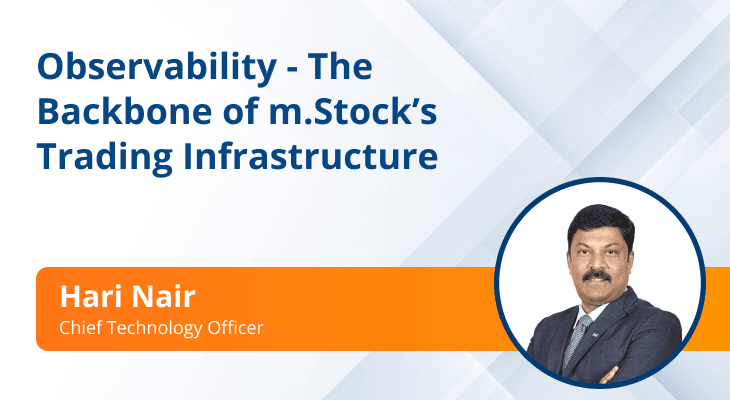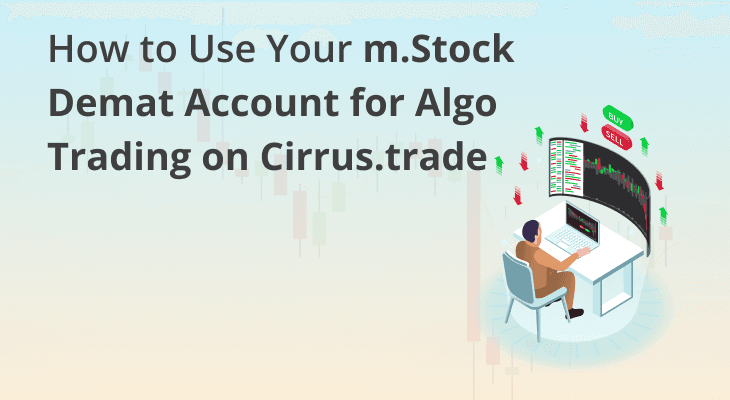
Why Observability Is the Backbone of m.Stock’s Trading Infrastructure
As one of India’s fastest-growing trading platforms, m.Stock powers millions of equity, F&O, mutual fund, and IPO transactions every single day. At this scale, delivering a seamless and trustworthy customer experience isn’t just about having a great UI or robust APIs. It hinges on something far deeper—Observability.
Let me explain why.
The Problem: Complexity at Scale Demands Observability by Design
Trading platforms today are far more than just order engines. At m.Stock, a single customer trade traverses a web of interconnected systems—from mobile apps and APIs, through our order and risk management layers, all the way to exchange interfaces. That journey must remain watertight.
Here’s what we’re up against:
1. Multi-Stage, High-Stakes Transactions
Every transaction involves a complex dance: app → auth gateway → OMS → RMS → exchange. A tiny delay in one hop can trigger a cascade. With over 2 million trades a day (Source: internal benchmarks), even a 0.1% failure rate can impact thousands of users.
2. Heterogeneous Systems and Vendors
From cloud infra to KYC to exchanges, we depend on multiple internal modules and external partners. If a single API call fails or protocol versions diverge, the system needs to know where and why—in real-time.
3. Trust Hinges on User Experience
If a trade fails, if there’s a delay, or worse, if a user doesn't know what went wrong, trust erodes fast. In financial services, that’s existential.
4. Incident Response and Dispute Resolution
Without observability, resolving user complaints becomes guesswork. For regulated platforms, traceability is not just good practice—it’s a compliance requirement.
5. Sheer Scale
Imagine a system that processes millions of transactions daily, each with its own latency, dependency, and user impact. Any failure has a magnified ripple effect. Quick detection and resolution are non-negotiable.
The Solution: Observability That Goes Beyond Monitoring
We needed a system that wouldn’t just monitor health checks but understand system behaviour. That’s where our Business Observability Platform—powered by VuNet Systems—comes in, grounded on three pillars: Deep Observability, Traceability, and Transparency.
1. Deep Observability: Seeing the Whole Picture
- Full-Funnel Monitoring: We observe every transaction from tap to trade—app, API, service, DB, queue, and exchange. Think of it as a heatmap of every user’s journey.
- Data from Every Layer: Our system captures metrics, logs, traces, and user interaction data across layers. Whether it’s memory spikes in the backend or API latency from a vendor, we see it.
- Internal vs External Fault Isolation: Was it our API? An NSE link? A third-party auth service? We identify root causes fast to restore services quickly and accurately.
2. Traceability: Following Every Digital Footprint
- Unique Transaction IDs: Every trade, session, and event carries a unique identifier. If a customer flags an issue, we track their session down to the millisecond.
- Structured Logs + Intelligent Tagging: With structured logging across systems, we correlate system behaviour, user actions, and backend responses, enabling precise diagnostics.
- Root Cause Analysis: Our RCA time has dropped by over XX% in the last X months since deployment—vital for both operations and compliance reporting.
3. Transparency: Tech That Builds Trust
- Stakeholder Visibility: From product heads to partner banks to the compliance team, everyone gets context-specific views into platform performance.
- Protocol Dispute Resolution: When inter-system issues arise—like differing interpretations of order rejection codes—we now resolve them with data-backed clarity.
The Next Frontier: AI-Led Intelligence and Proactive Action for better Customer experience
Observability becomes a true game-changer when coupled with AI/ML. Here’s how we’ve taken our system to the next level:
1. Real-Time Analysis & AI Correlation
- Intelligent Correlation: Our platform correlates logs, traces, metrics, and anomalies automatically. This enables real-time insights across physical infra, app logic, and customer transactions.
- Anomaly Detection: Using ML models, we detect outlier behaviour—spikes in latencies, transaction errors, or drops in API success rates—even before customers report them, thereby allowing for timely action.
2. Predictive & Prescriptive Analytics via GenAI
- Proactive Issue Detection: Predictive models flag conditions that typically precede outages—like memory leaks or network jitter—well before impact.
- Autonomous Operations: GenAI helps auto-analyse logs, auto-tag patterns, and recommend fixes. Our ops teams now resolve routine incidents up to XX% faster.
3. Enhanced Customer Experience = Business Resilience
- Seamless Transactions: By eliminating blind spots, we’ve improved successful transaction throughput during peak hours by XX% year-over-year.
- Faster Resolution = Higher Trust: With first-response times shrinking, our customer satisfaction scores have seen measurable improvement. Quick issue resolution and transparency has caused this.
- Self-Improving Feedback Loop: Every alert, RCA, and customer query feeds back into the system—making it smarter and more resilient.
To conclude: Observability Is Not a Choice—It’s Philosophy.
In a business where milliseconds matter and trust is currency, observability isn’t just a tool. It’s a Way of Life.
At m.Stock, we’re not just building a platform—we’re engineering confidence. And as we scale, evolve, and serve millions more, observability will remain at the heart of every decision we make. With our observability platform and its hyper-configurability, we now have a unified lens into every trade, every session, and every anomaly-empowering us to detect, respond, and optimize in real-time, ensuring seamless customer experiences and resilient operations.


